Iranian Art Museum Garden: Tehran Miniature Marvel
The Iranian Art Museum Garden (باغ موزه هنر ایرانی), located in the Elahieh district of Tehran, provides a unique cultural experience for visitors.
Its landscaped grounds showcase meticulously crafted miniature replicas of renowned Iranian architectural landmarks, offering a condensed overview of the nation's rich historical tapestry. Visitors can embark on a self-guided exploration of these scaled-down wonders, appreciating the intricate details and diverse styles on display.
Beyond the miniatures, the museum garden houses a contemporary art exhibition and a traditional craft shop, further enriching the experience by highlighting both modern and time-honored artistic expressions of Iran.
Whether seeking historical exploration, artistic immersion, or simply a serene escape in the heart of Tehran, the Iranian Art Museum Garden offers a worthwhile destination for discerning travelers.
Interested in visiting Iranian Art Museum Garden?
Check out our Tehran tour packages to find an itinerary that includes visiting the museum garden
or...
Design your own tailor-made itinerary and include Iranian Art Garden in it by yourself, today!
The History of Iranian Art Museum Garden
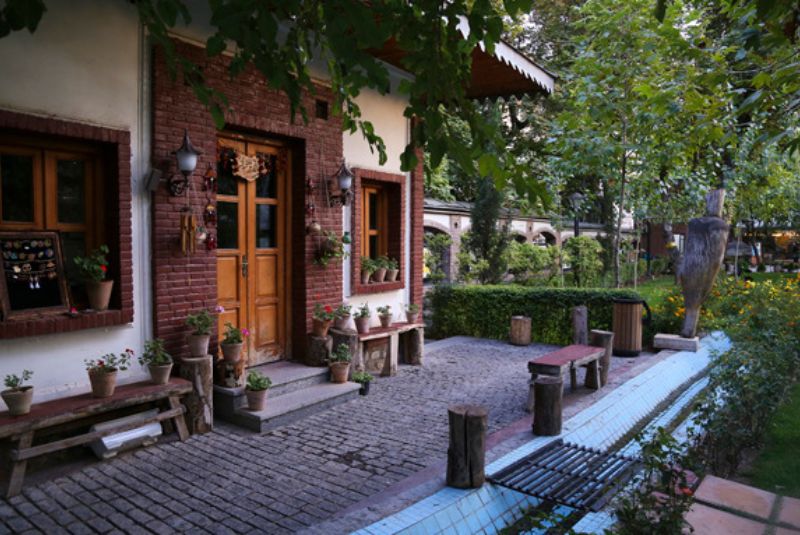
The Iranian Art Museum Garden, nestled in the charming Elahieh district of Tehran, boasts a history as intriguing as the miniature masterpieces it showcases. Its journey began in 1931, not as a museum, but as a private residence for Lieutenant General Ahmad Amir Ahmadi, a prominent figure in Reza Shah's reign.
Following the Iranian Revolution, the property entered a new chapter. It changed hands several times, eventually finding its way under the custodianship of the House of Cinema.
In 2005, a metamorphosis began. Extensive renovations and meticulous landscaping breathed new life into the space, culminating in the winter of 2006 with the triumphant opening of the Iranian Art Museum Garden. This transformation was more than just a physical rebirth; it was a dedication to preserving and showcasing the essence of Iranian art and architecture for generations to come.
| Read more: Best Museums in Tehran - Definitive Guide
Iranian Art Museum Garden Architecture and Design
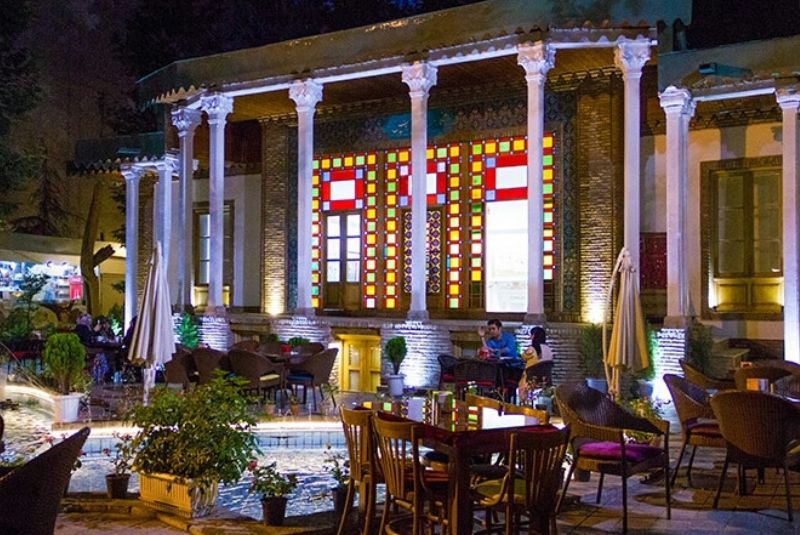
While there might be some subtle influences from traditional Persian gardens like the Fin Garden, the architecture of the Iranian Art Museum Garden is quite different. Here's a breakdown of its key features:
- Similar to traditional Persian gardens, the Iranian Art Museum Garden is enclosed by high brick walls, offering privacy and a distinct sense of place.
- A central pathway, lined with lush greenery, runs north-south through the garden, culminating in a serene water feature.
- Flowers, shrubs, and trees are arranged in geometric patterns, creating a harmonious and ordered atmosphere.
- Although not originally present, the addition of small canals and ponds contributes to the tranquility of the garden, reflecting the influence of classic Persian garden design.
- The overall layout and design principles of the Iranian Art Museum Garden echo elements of classic Persian gardens, such as the emphasis on water, symmetry, and greenery.
- While the garden draws inspiration from tradition, it also incorporates contemporary elements like sleek concrete pavilions and minimalistic landscaping techniques, creating a unique blend of old and new.
- Throughout the garden, visitors can find exquisite tile work, decorative fountains, and carefully arranged stones, adding a layer of visual richness and craftsmanship.
- Unlike the statement-making miniature pavilions, the main building located in the northwest corner is a relatively simple two-story structure. The building features a traditional brick facade and a gabled roof, harmonizing with the overall garden aesthetic. Today, the main building serves primarily as an administrative and cafe space for visitors to the garden.
| Read more: Elements of Persian Architecture
Exploring the Iranian Art Museum Garden

The Iranian Art Museum Garden offers a unique and captivating experience. It's a harmonious blend of traditional Persian garden design with contemporary artistic expression, creating an oasis of beauty and cultural richness. Let's discover different parts of this charming space:
Miniature Marvels
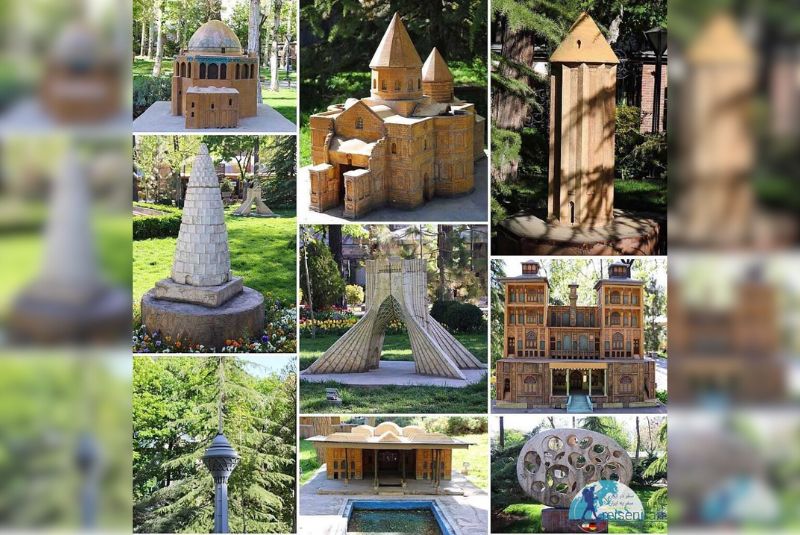
Stepping into the garden is like entering a miniature wonderland. The outer area boasts a collection of 11 exquisite replicas of iconic Iranian landmarks, each meticulously crafted from reinforced concrete. These miniature marvels, built by Italian architects to commemorate the 2500th anniversary of the Persian Empire, are so detailed that they transport you to the very essence of the original structures:
- Eight Heavens (Hasht Behesht): A dazzling pavilion in Isfahan renowned for its mesmerizing mirror work and serene gardens. Originating from the Safavid period in Isfahan approximately 350 years ago, the palace boasts a two-story structure surrounded by a spacious garden. Initially part of the "Great Garden of Naqsh Jahan," a segment was designated for Hasht Behesht Palace by a Safavid king, potentially serving as Shah Suleiman Safavid's residence.
- Forty Pillars (Chehel Sotoun): The replica within the Iranian Art Museum may not capture the original palace's vast 67 thousand square meters, but it stands as a small yet beautiful representation of the main structure. Constructed during the reign of Shah Abbas I, the fifth Safavid dynasty king, Chehel Sotoon Palace saw additions like the Hall of 20 Pillars, the Hall of Mirrors, royal hall porches, and a pond during Shah Abbas II's rule, completing the palace's present form.
- Qamoos Dome Tower: A towering brick tomb showcasing the grandeur of Seljuk architecture. Situated in Golestan Province, holds the distinction of being the world's tallest brick tower after India's Qutab Minar. Commissioned by King Qaboos bin Vashmgir, also known as Shams-ul-Maali, the tower stands as a testament to the Ziyarian rule during the 4th and 5th centuries of Hijri. Qaboos faced political challenges, enduring 18 years of leadership deprivation before reclaiming power in Gorgan. Despite being recognized as a writer and poet, Qaboos met a tragic end, issuing his own veiled murder order, leading to rebellion, removal from government, and eventual death. The Qaboos Dome Tower, where he was buried, stands at 72 meters in Tehran and offers a meaningful visit.
- Sultanieh Dome: Represents a concrete replica of the original dome located in Zanjan province. Commissioned by "Sultan Mohammad Khodabandeh" approximately 700 years ago, this dome, ranking as the third largest in the world, holds historical importance as the burial site of "Uljaito" or "Sultan Muhammad Khudabandeh."
- Shams-ul-Amara: A breathtaking pavilion adorned with intricate tile work and offering panoramic views. It howcases a meticulous replica of the original garden's beauty. The main building's details have been faithfully recreated, enhanced by oil paint to mirror the splendor of the original structure. Originally a symbol of Tehran before the Sardar Bagh Melli's construction, Shams-ul-Amara Mansion, a five-story building reaching 35 meters in height, remains an iconic and historically significant structure.
- 33 Bridges of Isfahan: A series of interconnected bridges spanning the Zayanderud River, a testament to Safavid engineering brilliance. Built by Ostad Hossein Bana Esfahani and commissioned by Allahvardi Khan Ondiladze, the most beloved general of Shah Abbas the Great. Historically, it served as the venue for ceremonies like "Abpashan" and "Khajshovyan" celebrations, and the annual Abpashan festival. The Siusepol Bridge, a masterpiece of bridge construction, is replicated in the museum's garden, offering a glimpse of Isfahan's architectural beauty.
- Fin Kashan Garden: A serene oasis showcasing the classic elements of Persian garden design. Dating back to the Safavid era, the Fin Kashan Garden holds significance, registered as a national monument in 1314 and listed on the UNESCO World Heritage List in 2009. Known for its historical, cultural, and architectural richness, the garden also gained acclaim as the most visited tourist spot in Isfahan.
- Naqsh Rostam: An ancient necropolis with impressive rock-cut tombs dating back to the Achaemenid era. Ascaled-down version of the ancient Naqsh Rostam site in Marvdasht, Fars province. This site encompasses reliefs, historical wall inscriptions, the Zoroastrian Kaaba, and the tombs of four Achaemenid kings. Naqsh Rostam, previously known by various names like Seh Gonbadan and Do Gonbadan, possibly earned its title due to a perceived connection between the Shahnameh character Rostam and the reliefs in this location. Notably, the tombs of Darius the Great, Xerxes, Ardashir I, and Darius II are carved into the rocks, inaccessible from the ground.
- Azadi Tower: Constructed in 1349 by "Hossein Amanat," stands as the newest addition to the Iranian Art Garden replicas. Serving as one of the current symbols of the capital, the tower's architecture is a fusion of Achaemenid, Sasanian, and Islamic era influences.
- Milad Tower: The tallest tower in Iran, offering breathtaking panoramic views of the city.
- Daniyal Nabi Tomb: A mausoleum dedicated to the prophet Daniel, revered by Muslims, Jews, and Christians. Located in Shush city, Khuzestan province, this tomb, built during the Seljuk dynasty, features an Urchin dome and two shells, standing about 20 meters high. Stories about Daniyal Nabi's burial place vary, with traditions suggesting relocation due to conflict in Shushtar or after Muslim attacks. Daniyal Nabi, a Jewish noble captured by the Babylonian king, served faithfully until Cyrus the Great's conquest of Babylon.
- Mahayar Caravanserai: A historical caravanserai along the Silk Road, offering a glimpse into the past. Registered as a national monument on June 20, 1321, this caravanserai is situated in Mahyar village, Shahreza city, Isfahan province. Notably, the caravanserai's proximity to a bakery, coffee house, mosque, and market during its time made it stand out. Built during the reign of Shah Ismail I Safavi approximately 450 years ago, it underwent restoration during Shah Suleiman Safavid's rule to address damages over time.
- Qara Kilasa: A mysterious fortress perched atop a cliff, shrouded in legend and history. Also known as the Church of the Iranian Art Museum, features a faithful replica of the "Holy Thaddeus" Church in West Azarbaijan province. Dating back to the early periods of Christianity, this church was built on the tomb of Saint Thaddeus, one of Christ's apostles. Recognized as an important pilgrimage site for Christians worldwide, the church holds historical significance due to the martyrdom of Saint Thaddeus in 66 AD.
Beyond the Miniatures
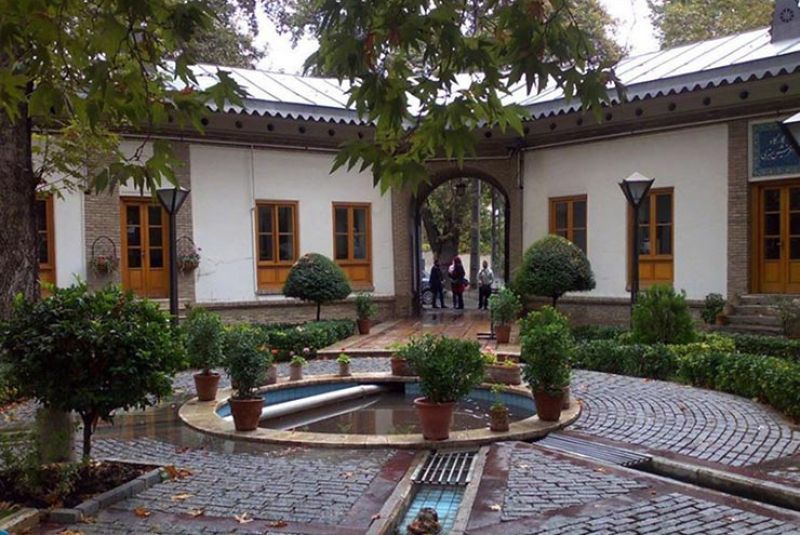
But the Iranian Art Museum Garden offers more than just miniature marvels. Step into the inner space, and you'll be greeted by a vibrant hub of contemporary art. Here, you can discover:
- Art Exhibitions and Workshops: Immerse yourself in the works of talented Iranian artists, from captivating photography exhibitions held monthly to educational workshops in painting, calligraphy, and other artistic disciplines.
- Green Space and Iranian Garden: Take a moment to breathe amidst the serene beauty of the garden, landscaped in the traditional Persian style with lush greenery, cascading water features, and fragrant flowers.
- Handicraft Sales Center: Treat yourself to a unique souvenir or simply admire the exquisite craftsmanship of Iranian artisans, from pottery and ceramics to textiles and jewelry.
- Cafe: Relax and unwind with a refreshing beverage in the charming cafe, surrounded by the vibrant atmosphere of the garden.
- Galleries: Explore Iranian art museum garden artworks in the Pardis Gallery and Renovation Gallery, showcasing a diverse selection of contemporary art and offering a glimpse into the creative landscape of Iran.
| Suggestion: Tehran's Most Famous Palaces
Iranian Art Museum Location and Access
Address: Tehran, Tajrish Square, Shahid Darbandi St. (Maqsoodbeig), Dr. Hasabi St., No. 30
Reaching the Garden:
If you plan to visit this complex by subway, bus, or taxi, you must reach Tajrish Square by one of the mentioned vehicles. From Shahid Darbandi Street, taxis go to the Art Museum Garden. Of course, if you like walking, you can reach the park by walking for about 20 minutes.
Best Time to Visit Iranian Art Garden Museum
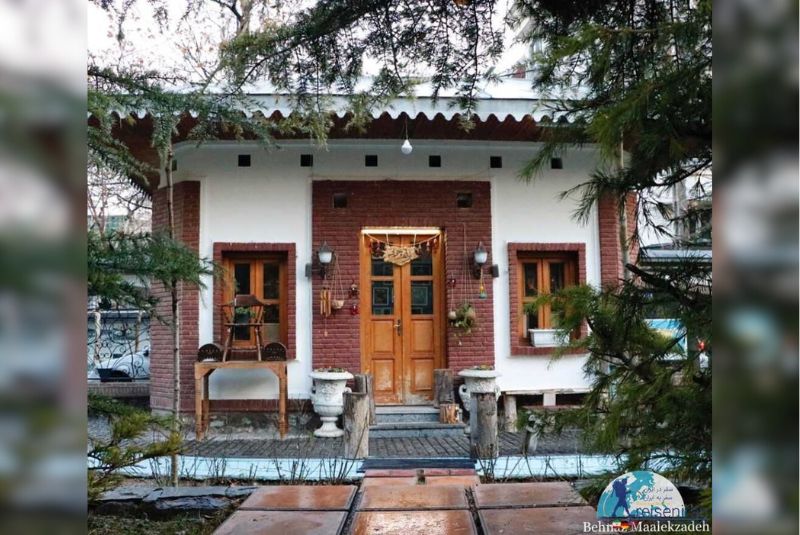
While spring paints the Iranian Art Museum Garden in a vibrant palette of blooming flowers and boasts the most comfortable temperatures, it also attracts the largest crowds. For a quieter escapade, autumn offers crisp air, dappled sunlight filtering through changing leaves, and manageable visitor numbers. Winter, though the chilliest, paints the miniature replicas in a charming blanket of snow and welcomes you with the warmest cup of tea at the garden's cozy cafe.
Ultimately, the best time to visit depends on your preference for crowds, weather, and a touch of whimsical winter magic. So pack your curiosity and choose your season – the garden's treasures await!

Final Takeaway
Whether you're an art enthusiast, a history buff, or simply seeking a tranquil escape, the Iranian Art Museum Garden has something for everyone. It's a place to learn, to be inspired, and to connect with the rich cultural heritage of Iran. So, come wander through its miniature marvels, discover hidden artistic gems, and lose yourself in the beauty of this unique oasis in the heart of Tehran.
Share your story!
Comment below and let us know about your Experience.
Your story inspires others!


Comment
Leave a Comment